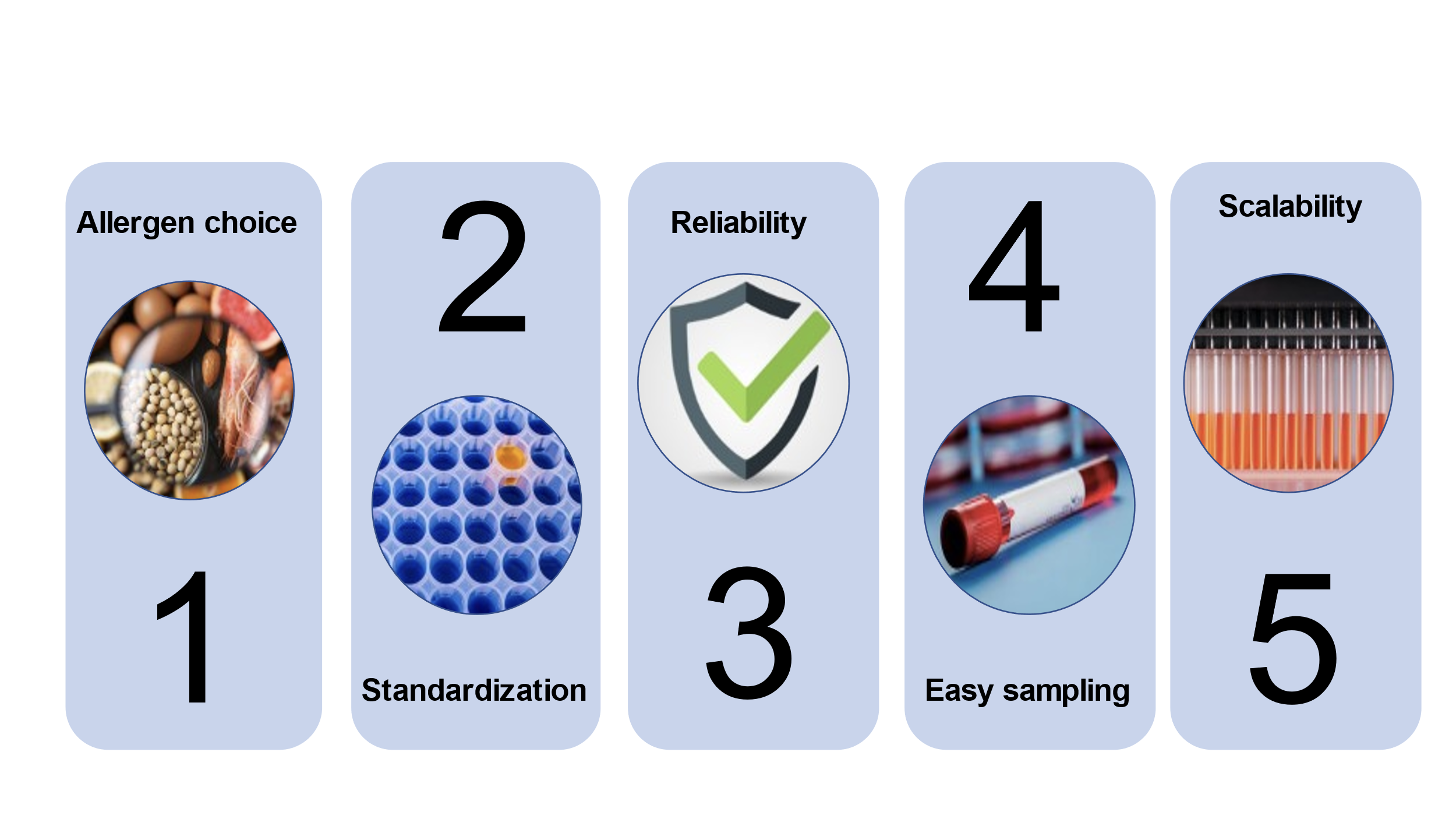By Hannah van Schijndel (Artemis) and Dajana Domik (Tecan)
It is estimated that up to 20% of the world’s population may have some degree of food intolerance, which can manifest itself in pathologies such as celiac disease, dermatitis, atopic eczema, inflammatory bowel disease (IBD) and irritable bowel syndrome IBS.1 We established in our previous article that IgG and IgG4-based ELISA testing can be used to reduce the guesswork in identifying food sensitivities, and is indeed the most widely used immunological method, despite the major challenges associated with it. 2-5
These challenges include deciding which allergens to test, choosing which physiological criteria and biological markers to use, ensuring that the tests are sufficiently standardized, all whilst guaranteeing that testing remains economically viable. So how can that be done in reality? For this final article in our food intolerance series, we talk to Artemis Laboratory, where Hannah van Schijndel takes us through the essential ingredients for setting up food intolerance testing in the lab.
If food intolerance is suspected, total IgG levels may need to be measured over a broad range of potential food allergens. We discuss the essential ingredients for setting up food intolerance testing in the lab.
Hannah, welcome. Maybe you can start by giving us some background as to how Artemis is set up to help patients who may have issues with food intolerance?
HvS: Thank you, and yes, of course. We first started Artemis Foods because we saw a need to associate a conventional, evidence-based medicine with a more holistic approach. And that’s working very well: we’ve found that by combining our science-based approach to food intolerance testing together with looking at lifestyle and dietary factors, we really can more positively impact our patients’ overall health.
In the case of a patient presenting with what could be food intolerance, once we suspect that IgG and IgG4 antibodies are involved, we’ll then perform a series of standardized ELISA-based tests. That will help us find out which exact food groups elicit an immune reaction in the patient and might therefore be causing that intolerance.
I say “might”, since an immune response may or may not be associated with their symptoms, because elevated levels of IgG antibodies do not always indicate a hypersensitivity. You can see high IgG antibody levels without symptoms, depending on a patient’s individual diet.6 They can simply mean that the patient has ingested a particular food and be part of a normal immune response. So, any IgG ELISA analysis on its own is only a tool, albeit a very useful one, rather than a diagnosis.
However, if, as we do, you go on to consider these higher IgG antibody levels in combination with patient interviews, and other physiological criteria, you can start to see if they really could be associated with delayed food hypersensitivity. In general, you’d do that with a very careful diet, where avoiding specific foods is followed by their controlled reintroduction, whilst closely monitoring your patient’s symptoms. We try to do that in such a way as not to be too restrictive, since it is very easy for a patient’s diet to become unbalanced, so they risk ending up with long term nutrient deficiencies.
Moving onto the practicalities, what would you see as the five essential ingredients for setting up food intolerance testing?
HvS: In short, we need tests that are standardized and reliable, with a relevant choice of allergens, and sampling must be simple and non-invasive. And because the calling for food intolerance tests is huge and ever-increasing, this means that whatever method of testing we use, it must be scalable. So food intolerance testing is finding that sweet spot that combines allergen choice, standardization, reliability, easy sampling, and scalability.

Figure 1: the five essential ingredients for food intolerance testing
Can you maybe help us break down each of those ingredients in a little more detail, starting with how you choose your allergen panel?
HvS: The practitioner should always start by looking carefully at the symptoms of the patient. If they are not sure whether there might be an IgG problem, they would then test for total IgG levels over a broad range of potential food allergens.7 And of course, you must always do these tests in conjunction with the medical history of the patient and any ongoing symptoms when ingesting certain foods before making any kind of diagnosis or nutritional recommendation.
The tests that Artemis Foods offers cover multiple food groups and include, for example: Artemis Foods Baseline 20; Artemis Foods Vegetarian 90 ELISA; Artemis Foods Premium 280, amongst others.
The Artemis 280 ELISA tests are the most comprehensive ones we have available: the Artemis Foods Premium 280 test allows you to analyze the IgG antibodies in your patient's blood for up to 280 different nutrients.
Secondly, even if we’ve chosen our allergens in principle, what can you say about the different levels of standardization that are required?
HvS: Once practitioners have decided which allergens might be relevant for patients with undefined potential food intolerances, they must indeed be sure that these allergens are prepared in a standardized way for use with different patients and in different labs. Standardization of allergens is vital for food intolerance testing to be taken seriously.8
Then there is the question of “standardization” of the results and of their interpretation. This takes me back to your last article, where you mentioned that it’s difficult to talk in terms of “absolutes” when it comes to standardization of IgG-based food intolerance ELISAs, because the concentration of a food-specific IgG is always going to be specific to an individual. So, sure, you do find that individuals have very different levels of different food-specific IgG antibodies, but although it might seem hard to nail them down to specific reference ranges for a given foodstuff, you do get a feel for them, and get to see patterns, particularly when you start to talk to patients about their diets and detailed food diaries.
After allergen choice and standardization, how about reliability?
HvS: ELISA food intolerance tests must be prepared in a completely standardized way, and if they are, they will also be reproducible in experimental terms, with CVs [coefficients of variation] within defined tolerance limits. A general rule of thumb is that the ELISA inter-assay CV, whether between batches, people, or labs, should be <15%, and the intra-assay CV across triplicates should be <10%. The criteria used by Tecan are 5-9% for inter-assay CV, and 13% for intra-assay.
To get that level of reproducibility implies that the food allergens used to coat the test plates must also be prepared in a standardized way. As you said before, ELISA tests for food intolerance would be useless without a standardized way of preparing the food antigens used, plus suitable internal standards, and an idea of what would be “normal” control levels of IgG in the patient samples for the foods tested.
Just doing a Google® search, you can see that there are very many ELISA tests available for food intolerance. However, in many of these, the antigen preparation and content is not necessarily standardized, or comparable from one test to the next, making it difficult to make decisions regarding the clinical significance of any result.
We’re glad to have settled with a set of tests where we know exactly which antigens we are using, and are confident that they come from controlled and audited sources. You can see an outline of what we provide below (Fig. 2), and on our website.

Figure 2: IgG-based ELISA tests available from Artemis
Thinking next about ease of sampling, what are the methods you’d recommend?
HvS: The ELISA tests used at Artemis are mostly done using venous blood samples. However, they can also be carried out using minimally invasive sampling of capillary blood, like a finger prick test for example, which can help to increase patient comfort - and hence ultimately help increase food intolerance testing uptake and acceptance.9 That option can also help labs that don’t necessarily have access to a phlebotomist.
Then we come to your last essential ingredient, scalability. What do you say to a lab, maybe one that’s starting out, that wants the flexibility to scale-up—and maybe even down—depending on demand?
HvS: When you’re starting out with food intolerance testing, as with any service of this type, you need to make the choice between setting up tests manually, or automation. That’s going to depend on the number of tests your lab is running, and on the level of skill you already have available in your lab.
In the case where your lab already has a reasonable skill level, and wants to start small, with for example dozens of tests, a manual solution could work well. However, even with lower numbers of tests like this, for absolute peace of mind and speed, automation could be considered.
Then when you want to scale up, into the 100s and 1000s, you should consider automation. Tecan can support you to set up combined automated solutions depending on your test workload, and whether your lab offers other kinds of tests as well, such as sex hormone testing. At Artemis we work with the Freedom EVOlyzer®, so we can provide high throughput automated solutions for food intolerance testing to the medical community (Fig. 3).

Figure 3: Automated food intolerance testing at Artemis Foods: Hannah van Schijndel is pictured using the Freedom EVOlyzer
Automating ELISA tests will typically give you results that are equivalent to an experienced manual worker, whilst removing much of the potential for human error. Working with machines like the EVOlyzer, the results are more reliable because the chance of making a mistake is just so low.
And finally, Hannah, what vision do you think Artemis has for the future of food intolerance testing?
HvS: I think that if we work collaboratively, across the scientific and medical communities, we will arrive at an agreed standardization of food intolerance ELISA tests, as has been done in other areas, such as infectious disease and hormone testing. At this point, the specific food allergen panels with proven clinical significance will start to be used even more broadly, contributing to the ultimate relief of the symptoms of many more thousands of patients, as well as having a positive impact longer term on the financial burden of food intolerance in healthcare.
Hannah, thank you for sharing your experience with us today.
HvS: Thank you, it was a pleasure.
Talk to your local Tecan expert about setting up food intolerance IgG-based ELISA tests.
About Hannah

|
Hannah van Schijndel, laboratory manager of Artemis laboratory is responsible for everything that happens in the laboratory. She manages the technicians, implements new projects and knows almost everything about analysis. She is specialized in diagnostics and clinical chemistry after graduating in biomedical technology. She also studied Health Care Management, so she understands better than anyone how the laboratory and everything around should function perfectly. |
References
- 1. Tuck, C. J., Biesiekierski, J. R., Schmid-Grendelmeier, P., & Pohl, D. (2019). Food Intolerances. Nutrients, 11(7), 1684. PubMed ID: https://pubmed.ncbi.nlm.nih.gov/31336652/
DOI: https://doi.org/10.3390/nu11071684
- 2. Zar, S., Benson, M. J., & Kumar, D. (2005). Food-specific serum IgG4 and IgE titers to common food antigens in irritable bowel syndrome. The American journal of gastroenterology, 100(7), 1550–1557. PubMed ID: https://pubmed.ncbi.nlm.nih.gov/15984980/
DOI: https://doi.org/10.1111/j.1572-0241.2005.41348.x
- 3. Zar, S., Mincher, L., Benson, M. J., & Kumar, D. (2005). Food-specific IgG4 antibody-guided exclusion diet improves symptoms and rectal compliance in irritable bowel syndrome. Scandinavian journal of gastroenterology, 40(7), 800–807. PubMed ID: https://pubmed.ncbi.nlm.nih.gov/16109655/
DOI: https://doi.org/10.1080/00365520510015593
- 4. Canavan, C., West, J., & Card, T. (2014). The epidemiology of irritable bowel syndrome. Clinical epidemiology, 6, 71–80. PubMed ID: https://pubmed.ncbi.nlm.nih.gov/24523597/
DOI: https://doi.org/10.2147/CLEP.S40245
- 5. Velikova, T., A Kukov, A. et al. (2018). Methods for detection of food intolerance. R Adv Food Sci: 1(3): 106-119 ISSN: 2601-5412 11
- 6. Gocki, J. and Bartuzi, Z. Role of immunoglobulin G antibodies in diagnosis of food allergy (2016) Postepy Dermatol Alergol. 2016 Aug; 33(4): 253–256. Published online 2016 Aug 16. doi:
PubMed ID: https://www.ncbi.nlm.nih.gov/pmc/articles/PMC5004213/
DOI: https://doi.org/10.5114/ada.2016.61600
7. Ibl International. https://www.ibl-international.com/en/search/food%20intolerance Accessed 17 October 2022.
- 8. Zimmer, J., Bonertz, A., & Vieths, S. (2017). Quality requirements for allergen extracts and allergoids for allergen immunotherapy. Allergologia et immunopathologia, 45, 4-11.
PubMed ID: https://pubmed.ncbi.nlm.nih.gov/29128092/
DOI: https://doi.org/10.1016/j.aller.2017.09.002
9. Google. https://www.google.com/search?q=food+intolerance+tests+ELISA Accessed 12 October 2022.
10. Tang, R., Yang, H., Choi, J. R., Gong, Y., You, M., Wen, T., Li, A., Li, X., Xu, B., Zhang, S., Mei, Q., & Xu, F. (2017). Capillary blood for point-of-care testing. Critical reviews in clinical laboratory sciences, 54(5), 294–308. PubMed: https://pubmed.ncbi.nlm.nih.gov/28763247/
DOI: https://doi.org/10.1080/10408363.2017.1343796
About the author
.jpg)
Dajana Domik
Dr. Dajana Domik joined Tecan in 2020 as a product manager responsible for the saliva portfolio as well as diverse other products, e.g. Immunology. Dajana has a scientific background and spent time in the USA as a postdoc and is now supporting the Global Reagent Marketing & Support Department with immunoassay solutions at Tecan.













